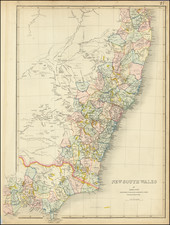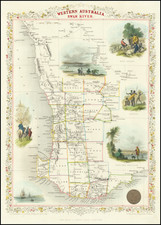Second State
Revised coat of arms, perhaps relating to the formation of the English East India Company, which obtained sovereign powers in about 1672.
Hugo (or Huych) Allard (or Allardt) (1627–1684 or '91) was a draughtsman, engraver, and painter during the Dutch Golden Age of cartography. Based in Tournai and Amsterdam, he was the founder of a prominent family of Dutch mapmakers, publishers, and print sellers. Allard set up his cartography business around 1645, and his first works were mostly reissues of earlier maps. Although not as prominent as the Blaeu family or Henricus Hondius and Jan Janssonius, Hugo Allard’s work, from about 1640 to 1680, is considered to be just as fine in quality. His output was relatively small, and his maps were mostly published as loose, separate issues, but they were well-designed and finely engraved. After Allard’s death, he left his business to his son, Carel. There is some confusion about when he died; some sources state 1684, others say 1691.
Nicolaas Visscher II (1649-1702) was a prominent Dutch cartographer and publisher during the late 17th century. He was the grandson of Claes Janszoon Visscher and the son of Nicolaes Visscher I, both of whom were also renowned cartographers in their own right. After his father's death in 1679, Nicolaas Visscher II took over the family's map publishing business.
In 1680, he married Elizabeth Verseyl from Gouda, and in 1682, he obtained a new privilege from the States of Holland and West Friesland to protect his maps and publications from being copied. Visscher II continued the family tradition of producing high-quality maps, atlases, and globes, often with elaborate and decorative elements. He maintained the Visscher family's reputation for accuracy and craftsmanship in the competitive world of Dutch cartography until his death in 1702. After his death, his widow, Elizabeth, and later his son, also named Nicolaas, continued the business until around 1726.











![(Mercator-Hondius Asia) A Leaf from the Mercator-Hondius World Atlas Edition of 1619 with an Essay by Norman J. W. Thrower [with map:] Asia ex magna orbis terre description Gerardi Mercatoris desumpta studio et industria G.M. Iunioris.](https://storage.googleapis.com/raremaps/img/small/101528.jpg)
![(1st State) [ First Map of Asian Continent ] India Extrema XIX Nova Tabula](https://storage.googleapis.com/raremaps/img/small/94610.jpg)
![[South Australia] Ports in the Gulf of St. Vincent and Encounter Bay Surveyed by Comr. J. Hutchinson R.N. and assisted by F. Howard & M.S. Guy Navl. Lieutts. R.N. 1869 (Port Victor, Port Elliott, Port Willunga and Port Noarlunga)](https://storage.googleapis.com/raremaps/img/small/38744.jpg)
![(Rare copperplate edition!) Asia Secunda Pars Terrae in Forma Pegasi [Asia in the Form of Pegasus]](https://storage.googleapis.com/raremaps/img/small/82046.jpg)